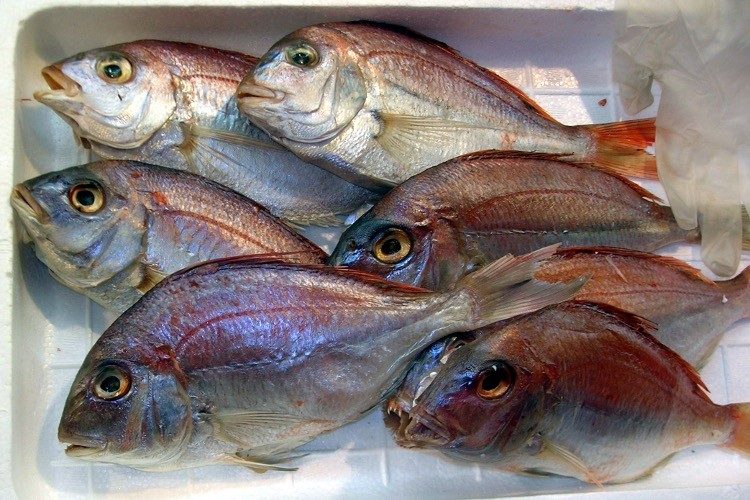
Japan is genetically modifying sea bream fish to have 50 percent more muscle and, according to Japan News/Yomiuri Shinbun, government approval is expected soon. Not surprisingly, there are concerns about what this will do to the environment and to consumers.
To make the sea bream grow to have more muscle, the myostatin gene — responsible for muscle growth restriction — will be modified so that it is incapacitated. Turning off the gene makes the fish grow more muscular than unmodified fish. By making the fish meatier, researchers are hoping to bring in more money to Japan’s aquaculture industry.
Japan’s fishing industry has been struggling, according to reports. Canada’s Hakai Magazine, a publication affiliated with the Tula Foundation, a British Columbia-based non-governmental organization (NGO) says, “Raising fish with more meat on their bones could boost commercial farming operations for red seabream, which struggle with narrow profit margins because of the high costs of supplying feed and restocking waters with young fish.”
The genetically modified fish are thought to be able to grow meatier without additional feed inputs, resulting in a competitive advantage intended to improve outcomes in the aquaculture industry.
The genome-editing tool being used on the red sea bream is called CRISPR-Cas9. Hakai Magazine says Masato Kinoshita, an assistant professor of applied biosciences at Kyoto University, is “using CRISPR-Cas9 to knock out the myostatin gene in the generation of red seabream.” CRISPR-Cas9 is used to selectively modify the genes of animals by snipping out or adding in new segments of DNA.
Genetic engineering offers promise, but also peril. In some tests, animals that have been fed genetically modified (GM) crops have either died or been seriously harmed. Researchers writing in the Avicenna Journal of Medical Biotechnology in 2011 listed some concerns with GM foods: “Rats exposed to transgenic potatoes or soya had abnormal young sperm; cows, goats, buffalos, pigs and other livestock grazing on Bt-maize, GM cottonseed and certain biotech corn showed complications including early deliveries, abortions, infertility, and also many died.” While these outcomes were obtained using earlier genetic manipulation techniques, there are concerns about species that have been genetically modified using CRISPR as well.
In 2019, Scott Gotlieb, then head of the FDA, said the agency would keep watch over CRISPR modified foods. “The FDA will evaluate the safety and effectiveness of an intentional genomic alteration based on the totality of the evidence presented,” Gottlieb wrote. “Our aim is to closely tailor regulation to risk,” he said.
In the case of sea bream, researchers are reporting that the attempt to modify the fish has been successful. During experiments, scientists observed that the modified fish had the same body weight as the non-modified fish, but had 16 percent more muscle. They also noticed that the modified fish had a shorter body length on average. The Japanese researchers tasted the modified fish and the only difference they noticed was that the meat had a softer texture.
Around the world, other researchers are continuing to pursue CRISPR-based gene modification applications.
Speaking to the journal Nature in 2020 in an article detailing the award of the Nobel Prize in chemistry to CRISPR pioneers Jennifer Doudna and Emmanuelle Charpentier, Martin Jinek, who was a postdoc in Jennifer Doudna’s lab, said, “We were hoping that we could really translate this into a technology for rewriting the genetic code of cells and organisms.” Jinek said, though, that the technology has advanced even more rapidly than expected. “What we didn’t quite appreciate was how quickly the technology would be adopted by others in the field and then pushed forward.”
Speaking to Yale Insights in 2018, biotech expert Dr. Greg Licholai shared his opinions about both the applications and dangers of CRISPR innovation.
“There are three main applications for CRISPR,” Licholai told Yale Insights. “One is in manipulating genes to turn them on or off within people. Another is to create medications that can be infused, or in some cases, self-therapy — taking blood and certain cells out of a body, manipulating them with CRISPR, and then putting them back in. The third, which sometimes is overlooked, is actually in farming.”
As for dangers, he pointed to “gene drive” applications. “What that means is that because you’re actually manipulating genes and those genes get incorporated into the genome, into the encyclopedia, basically, that sits within cells, potentially those genes can then be transferred on to other organisms,” he said. “And once they’re transferred on to other organisms, once they become part of the cycle, then those genes are in the environment.”
“That’s probably the biggest fear of CRISPR,” he concluded.
To address such concerns, the researchers behind the modified sea bream say safety measures have been put in place. Each edited fish is tagged for individual identification, and the fish are cultivated in tanks on land to avoid cross breeding in the wild. In addition, Japan News reported, government regulators will oversee safety matters. “A Health, Labor and Welfare Ministry expert subcommittee and other bodies will confirm, among other items, that new genes have not been inserted into the fish and whether the modified fish produces new allergens,” the paper reported.
The CRISPR modified sea bream is probably just the beginning for commercialization of CRISPR in the food supply and more broadly. But are we ready for this level of genetic manipulation in our everyday lives?
Speaking with Jennifer Doudna, one of the key discoverers of CRISPR, for Quanta Magazine, science writer Vanessa Schipani asked, “How do you think CRISPR has and will further basic biology research?” In answer, Doudna pointed to a project to investigate bipedalism. This project involves comparing the genetics of two rodents — a normal mouse and a bipedal rodent called a jerboa that hops on its hind legs.
“What if I start putting genes from the bipedal rodent into the other rodent?” Doudna asked. “Can I eventually make a bipedal field mouse? This is the kind of project that’s possible now with CRISPR.”

